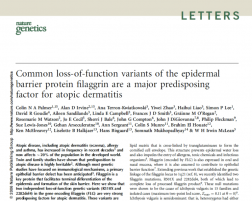Literature
Popular Press vs. Primary Research
This site was produced as an assignment for Genetics 677, an undergraduate course at UW-Madison (Sp'10)
Reviews of the Literature
The article in the New York Times covers the shift in focus on eczema as an allergic disease to possibilities of genetic roots for the condition. The author, Ingfei Chen, offers descriptive quotes the chief executive of the National Eczema Association, regarding how the condition affects the lives of those who suffer from it, in addition to a quote from Dr. Alan Irvine, a pediatric dermatologist and leading scientist in the discovery of a connection between the filaggrin gene and eczema. The gene, which is responsible for making a protein important in forming the skin’s natural moisture barrier, likely results in a strong predisposition to the skin disease when defective. However, as the article explores, there are still debates on the involvement of immunological responses in the manifestation of the condition, in conjunction with said genetic factors. Research has revealed that filaggrin levels can decrease as a result of inflammation, for example. Chen also mentions the new excitement over the possibilities of preventative drugs and genetic treatments for eczema as a result of the breakthroughs in the field. The article provides a good overview of the research going on in the field in a way that is understandable and thought provoking to those who have little previous background on the condition.
The paper by Irvine, A D, and Mclean, W H, et al, uncovers the filaggrin (FLG) gene as a strong pre-disposer to atopic dermatitis (eczema) and associated asthma. The research done by this lab was conducted on DNA samples from patients in the United States and Ireland, with all individuals exhibiting definitive eczema. After genotyping and statistical analysis, strong correlations between FLG null alleles and eczema were revealed, with two major FLG mutations seen most commonly in the samples (R510X and 2282del4). Notably, the researchers found that a high percentage, sixty percent, of individuals with an FLG loss-of-function mutation exhibited eczema by the age of three years. The researchers concluded that solid evidence had been demonstrated to connect predisposition to eczema with the mutated gene, suggesting future research focusing on the two common null mutations mentioned above.
Each article is designed for distinct audiences, and the styles of writing reflect this fact. While the popular press article is very easy to understand and contains common vocabulary, the primary research paper is very technical and dense. The New York Times article contains information that covers a wide spectrum of topics on the issue, and addresses debates on immunological factors in eczema that the primary literature does not delve in to. The popular press article actually references the research of the primary literature and provides direct quotes from one of its authors. Chen’s writing is entertaining and descriptive, with informative information on the background of eczema and a picture for added appeal. At the same time, Irvine, Mclean, et al, provide several helpful tables and figures that aid in the understanding of the highly scientific writing, making it accessible to scientists outside the realm of their particular area of study. Both articles are good pieces that leave the reader thinking about future research in the area as well as continued debate on the findings presented.
The paper by Irvine, A D, and Mclean, W H, et al, uncovers the filaggrin (FLG) gene as a strong pre-disposer to atopic dermatitis (eczema) and associated asthma. The research done by this lab was conducted on DNA samples from patients in the United States and Ireland, with all individuals exhibiting definitive eczema. After genotyping and statistical analysis, strong correlations between FLG null alleles and eczema were revealed, with two major FLG mutations seen most commonly in the samples (R510X and 2282del4). Notably, the researchers found that a high percentage, sixty percent, of individuals with an FLG loss-of-function mutation exhibited eczema by the age of three years. The researchers concluded that solid evidence had been demonstrated to connect predisposition to eczema with the mutated gene, suggesting future research focusing on the two common null mutations mentioned above.
Each article is designed for distinct audiences, and the styles of writing reflect this fact. While the popular press article is very easy to understand and contains common vocabulary, the primary research paper is very technical and dense. The New York Times article contains information that covers a wide spectrum of topics on the issue, and addresses debates on immunological factors in eczema that the primary literature does not delve in to. The popular press article actually references the research of the primary literature and provides direct quotes from one of its authors. Chen’s writing is entertaining and descriptive, with informative information on the background of eczema and a picture for added appeal. At the same time, Irvine, Mclean, et al, provide several helpful tables and figures that aid in the understanding of the highly scientific writing, making it accessible to scientists outside the realm of their particular area of study. Both articles are good pieces that leave the reader thinking about future research in the area as well as continued debate on the findings presented.


